I pace while I think. I’ve spent hours and days wandering around just thinking: what does PPARa do?
PPARa sits at the crossroads of fatty acid composition, antioxidant defense, inflammation, obesity and torpor. As winter approaches animals increase production of PPARa.
PPARa is a transcription factor (turns on other genes) that is hard to pin down. PPARa is both anabolic and catabolic at the same time. It’s role in catabolism is increasing fat oxidation, which does not increase NADPH. Yet PPARa activation is still required to continue NADPH generation during the respiratory burst. Part of this is done by activating Nrf2, but PPARa directly controls expression of the lipogenic, NADPH producing enzyme Malic Enzyme (ME). It is also involved in detoxification, decreases inflammation via suppression of NF-kB and it increases antioxidant defense. It increases expression of the lipogenic desaturase enzymes.
No human would design a system like this.
PPARa is activated by fatty acids. It is mildly activated by physiological levels of saturated free fatty acids. It is more strongly activated by the OEA your gut produces when you consume the monounsaturated fat oleic acid. I suspect this happens in mammalian systems because insects (the first mammals ate insects) become higher in monounsaturated fats as you venture further from the equator. The chart below is ants. Winter is coming, fatten up!
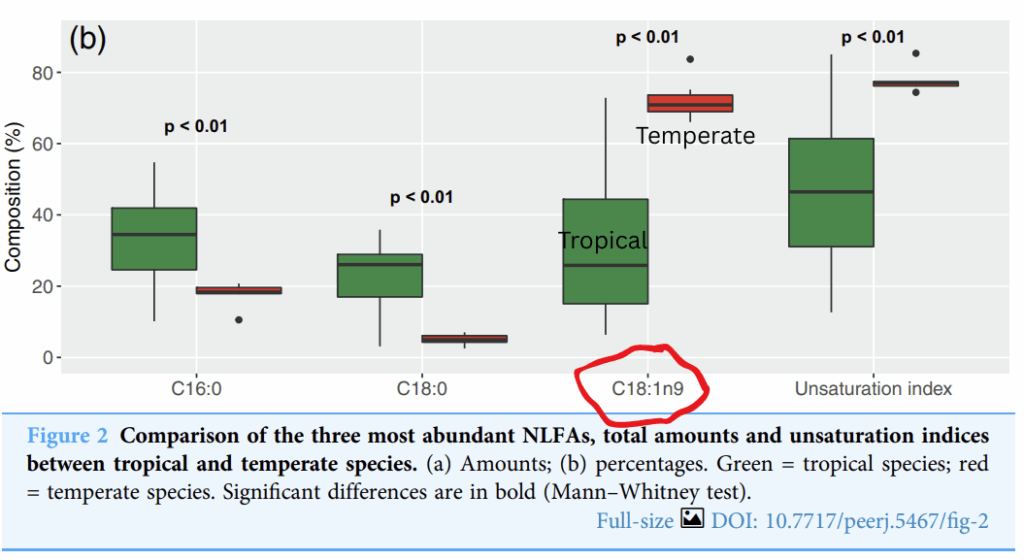
It is strongly activated by used fryer oil and transfats in margarine. Some long chain PUFA and branched chain fats activate PPARa.
The PFOA forever chemical from nonstick coatings (teflon, scotchguard) that circulates in your bloodstream activates PPARa. So do the Phthalates in the microplastics. Both of these things are in all of us.
Fenofibrate is a drug that activates PPARa. Much of what we know about PPARa is from experiments using fibrates. This title gives you an idea of the schizophrenic nature: “Fenofibrate Simultaneously Induces Hepatic Fatty Acid Oxidation, Synthesis, and Elongation in Mice”. The enzymes with the red lines are increased with fenofibrate.
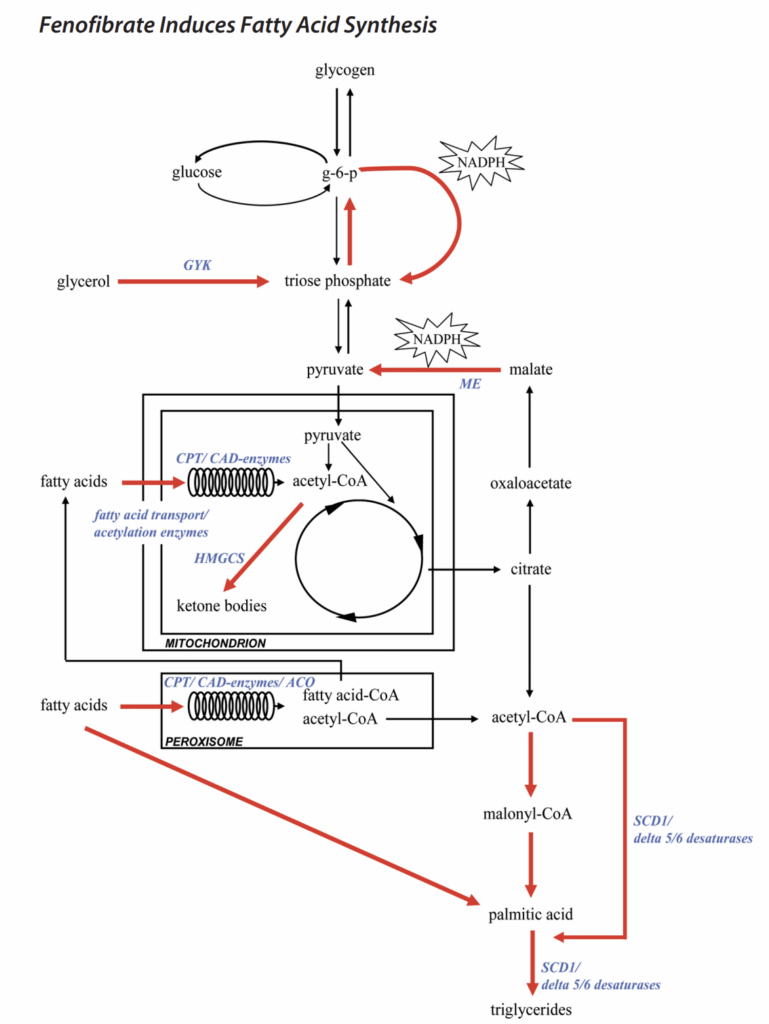
In the lower part of the diagram you can see fatty acids being sent to peroxisomes to produce mitochondrial acetyl-Coa, which are then turned right back into fat using the NADPH that was generated by increased expression of malic enzyme (ME). SCD1, D6D, D5D and ME are broadly understood to be lipogenic.
This Looks Like A Filter
Peroxisomes and mitochondria can both break down fats via beta-oxidation. Peroxisomes have stronger affinity for very long chain fats and weird fats. In most animals (not humans), PPARa increases peroxisomal volume.
Animals want their fat to be in a certain proportion. Different tissues and different organs vary, but only four fatty acids tend to dominate: palmitic, stearic, oleic and linoleic acid. Why does linoleic acid build up in animal tissues to a greater degree that linolenic? Linolenic activates PPARa, linoleic does not. There are often a decent amount of long chain omega-3 PUFA as well, depending on the tissue type and animal. How is this maintained if we are a copepod eating high PUFA algae all day?
It’s like this: PPARa senses a “weird” fat. Let’s stick with the previous example of copepods eating diatoms. The weird fat is alpha-linolenic acid. This is the fat found in flaxseed oil and it is a reasonably strong activator of PPARa. The weird fatty acids are sent into the peroxisomal wood chipper to get broken up into cytoplasmic acetyl-CoA. At the same, Malic Enzyme is activated along with Nrf2. NADPH production rises to power fatty acid synthase and the fats are rebuilt into the two primary end products of DNL: oleic and palmitic acid. The weird fats are gone. They are replaced with palmitic and oleic acid until there are no longer any weird fats to stimulate PPARa. Stasis returns.
| Fatty Acid | Type | Direction of Change with Fenofibrate |
|---|---|---|
| Oleic acid (18:1 n-9) | MUFA | ↑ (big increase) |
| Palmitoleic acid (16:1 n-7) | MUFA | ↑ (big increase) |
| DGLA (20:3 n-6) | n-6 PUFA | ↑ (big increase) |
| EPA (20:5 n-3) | n-3 PUFA | ↑ (moderate increase) |
| Palmitic acid (16:0) | SFA | ↑ (increase) |
| Linoleic acid (18:2 n-6) | n-6 PUFA | ↓ (big decrease) |
| Linolenic acid (18:3 n-3) | n-3 PUFA | ↓ (big decrease) |
| Stearic acid (18:0) | SFA | ↓ (big decrease) |
| DHA (22:6 n-3) | n-3 PUFA | ↓ (slight decrease) |
Here is how that change looks in the fatty acid profiles of the liver fat of the mice given fenofibrate. Looks like a filter.
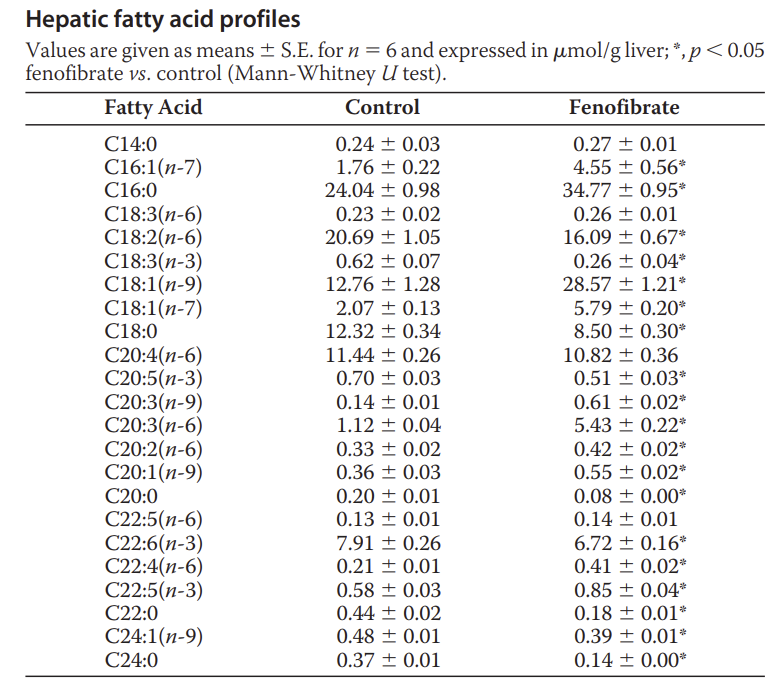
Worm fat is a hot mess
We branched from the worm clade before they developed PPARa. They don’t have it. They live in the soil and eat all kinds of weird stuff. As a result, their fat is a hot mess. No filter.
Saturated fats up to 32 carbons. Monomethyl branched chain fats. Isoprenoid branched chain fats. 17:1n8. This is nightmare stuff. PPARa is a filter.
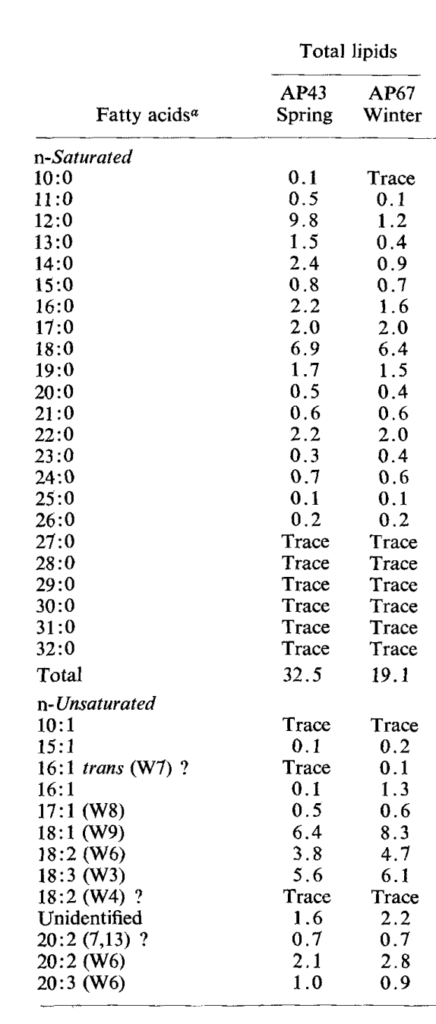
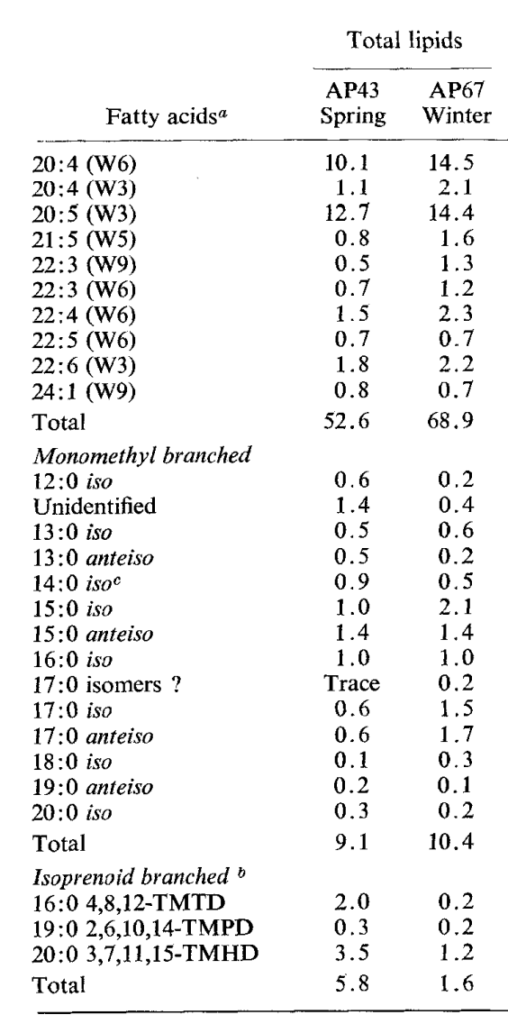
Hansen, Roy P., and Zofia Czochanska. “The Fatty Acid Composition of the Lipids of Earthworms.” Journal of the Science of Food and Agriculture, vol. 26, no. 7, 1975, pp. 961–71, https://doi.org/10.1002/jsfa.2740260713.
Ishida, Norio. “Role of PPAR α in the Control of Torpor through FGF21‐NPY Pathway: From Circadian Clock to Seasonal Change in Mammals.” PPAR Research, edited by Richard P. Phipps, vol. 2009, no. 1, 2009, p. 412949, https://doi.org/10.1155/2009/412949.
Oosterveer, Maaike H., et al. “Fenofibrate Simultaneously Induces Hepatic Fatty Acid Oxidation, Synthesis, and Elongation in Mice.” Journal of Biological Chemistry, vol. 284, no. 49, 2009, pp. 34036–44, https://doi.org/10.1074/jbc.M109.051052.
Rosumek, Felix B., et al. “Unveiling Community Patterns and Trophic Niches of Tropical and Temperate Ants Using an Integrative Framework of Field Data, Stable Isotopes and Fatty Acids.” PeerJ, vol. 6, Aug. 2018, p. e5467, https://doi.org/10.7717/peerj.5467.
